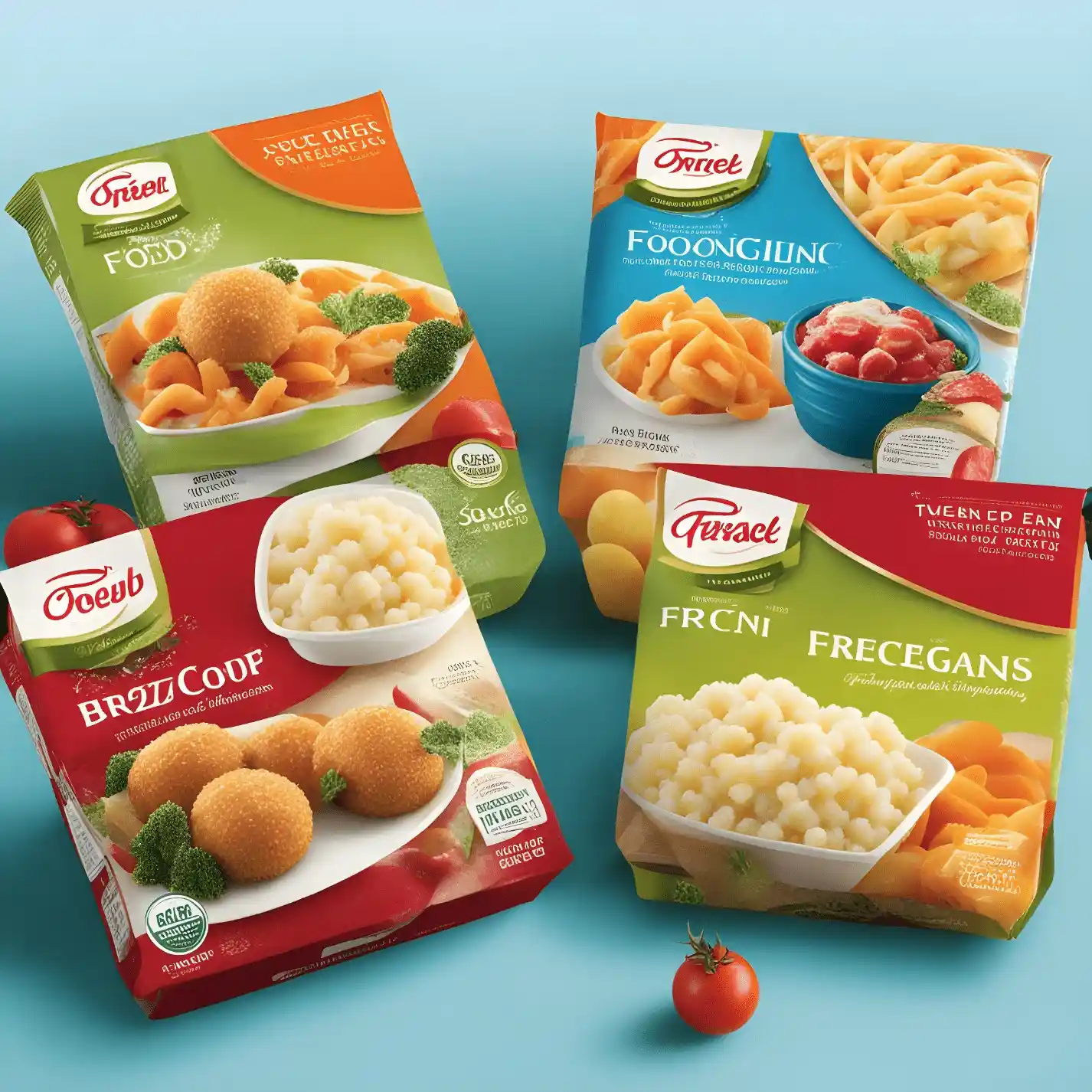Why Frozen Food Packaging Matters: The Impact on Sales

In gastronomic preservation, frozen food packaging emerges as the unsung hero, a sentinel of quality and taste. Understanding the nuanced world of packaging for frozen delights is paramount within this frosty kingdom, where frigid treasures await. This article delves into the intricacies of this realm, shedding light on the myriad types of packaging that safeguard edibles and wield considerable influence over the bottom line.
Imagine, for a moment, a world without thoughtful packaging – frozen feasts left vulnerable to the ravages of freezer burn and flavor degradation. Here, the story unfolds, emphasizing the symbiotic relationship between culinary creations and their protective shroud. Let’s journey through the subzero landscape where design, innovation, and preservation converge to orchestrate a compelling symphony for discerning palates.
The Visual Appeal of Frozen Food Packaging
In the intricate dance of commerce, where products clamor for attention on crowded shelves, visually appealing packaging emerges as the prima ballerina. It wields a magnetic charm, beckoning potential customers to take a closer look, and in the realm of frozen foods, this allure is a game-changer.
1. The Role of Visually Appealing Packaging in Attracting Customers
Imagine strolling through the freezer section of your local grocery store. Your eyes flit from one package to another, seeking something that stands out and promises more than sustenance. It’s the captivating design, the vibrant imagery, and the compelling allure of frozen food packaging design that draw you in.
Visually appealing packaging isn’t mere eye candy; it’s a strategic tool. It tells a story, communicates brand identity, and whispers promises of taste and quality. Consumers often make split-second decisions based on how a package looks. A well-crafted design can trigger an emotional connection, fostering loyalty and trust.
2. Custom Frozen Food Packaging: Tailoring It to Your Brand
In this competitive landscape, one size rarely fits all. In this scenario, specialized packaging for frozen food has a prominent role. It’s not just about slapping a logo on a box; it’s about crafting a visual narrative that aligns with your brand’s essence.
Customization allows you to infuse your packaging with personality. Each element can be tailored to resonate with your target audience, whether it’s choice of colors, typography, or imagery. It’s a chance to be unique in a sea of conformity, to showcase your brand’s values, and to leave an indelible mark in the minds of consumers.
So, as you contemplate the frozen food aisle on your next shopping excursion, remember that the most enticing packages are more than skin-deep. They result from thoughtful packaging design and the artful craft of custom frozen food packaging. They are the silent persuaders, inviting you to embark on a culinary journey beyond the frosty surface, promising a symphony of flavors that await within.
Ready to revolutionize your brand’s packaging and create a lasting impression? Dive deeper into the world of custom food packaging with our comprehensive guide: Revolutionize Your Brand with Custom Food Packaging: A Comprehensive Guide. Discover how customization can elevate your brand, capture your audience’s attention, and set you apart from the competition. Click here to explore the possibilities and make your packaging an integral part of your brand identity.”
Environmentally Friendly Packaging Solutions
The frozen food business is at a critical crossroads in a world that is becoming more mindful of its environmental impact due to the growing call for change. Now let’s look at the second act:

1. The Growing Demand for Eco-Friendly Frozen Food Packaging
As our planet’s fragility becomes more evident, consumers are sounding a resounding call for eco-conscious choices, even within frozen comestibles. The desire for environmentally friendly packaging is no longer a mere whisper; it’s a roaring tide of change.
This seismic shift in consumer preferences drives a tectonic transformation in the packaging landscape. It’s a testament to the collective desire to minimize environmental impact. From suburban kitchens to bustling urban centers, eco-warriors in aprons and suits seek frozen treasures encased in sustainable solutions.
2. Exploring Sustainable Materials and Options
The quest for sustainability has sparked a dynamic exploration of novel packaging materials and innovative options. The freezer section is becoming a laboratory of green packaging experimentation, from biodegradable films to recyclable cartons.
These sustainable materials reduce waste and redefine the aesthetics of frozen food packaging. They blend functionality with environmental consciousness, offering a glimpse of a future where every purchase aligns with a commitment to safeguard our planet.
In this evolving narrative, the frozen food industry is discovering that eco-friendliness isn’t just a trend; it’s a new standard. As consumers embrace the frozen aisle with eco-friendly fervor, the industry’s response is a testament to its commitment to sustainable progress, offering both choice and conscience on the frosty shelves.
Safety and Quality Assurance
A delicate ballet in the frozen food industry unfolds behind the scenes, where meticulous attention to detail is paramount. Here, two core pillars, food safety and the unwavering commitment to delivering quality products, take center stage.

1. Ensuring Food Safety through Packaging
Packaging in frozen cuisine isn’t just about aesthetics; it’s a guardian of public health. It weaves a protective cocoon around frozen delights, shielding them from external contaminants and temperature fluctuations. This commitment to food safety is non-negotiable.
The packaging serves as a fortress against the elements, preserving the integrity of the contents. It’s a formidable barrier that fends off freezer burn and microbial intruders, ensuring each bite is delicious and safe.
2. The Importance of Quality Products and Their Packaging
While the ingredients are the show’s stars, the supporting actor – the frozen food packaging material – plays a pivotal role. Quality products deserve nothing less than quality packaging.
It’s a harmonious partnership from robust materials that endure the rigors of freezing to designs that communicate excellence and trustworthiness. Quality in both product and packaging is the duet that elevates the consumer experience from ordinary to exceptional.
In frozen cuisine, safety and quality assurance are the underpinnings of consumer trust. They are the understated assurances that each frozen morsel reflects flavor and an unrelenting dedication to the highest standards of safety and quality.
The Versatility of Flexible Packaging

In the ever-evolving world of frozen food packaging, the spotlight now falls on the remarkable versatility of flexible packaging. Let’s explore this act:
1. Advantages of Using Flexible Packaging for Frozen Foods
Flexibility, in both literal and metaphorical senses, defines the allure of this packaging innovation. Unlike rigid containers, flexible packaging gracefully molds itself to the contours of its contents, eliminating wasted space. This snug fit translates to reduced shipping costs and a smaller environmental footprint.
Furthermore, flexible packaging is a guardian against the harsh environment of the freezer. Its superior seal integrity locks out frosty foes like freezer burn, ensuring that the gastronomic treasures within remain pristine.
2. Stand-Up Pouches and Their Suitability for Small Businesses
In flexible packaging, stand-up pouches emerge as the champions of frozen food packaging for small businesses. Their ingenious design maximizes shelf space efficiency, a valuable asset for enterprises with constrained retail real estate.
Furthermore, these pouches provide an expansive canvas for captivating graphics and branding, offering ample surface area to weave compelling narratives. They are cost-effective, effectively curbing production and shipping expenses, and align with environmental responsibility.
In the fiercely competitive landscape of small-scale frozen food producers, stand-up pouches stand as versatile allies, seamlessly blending convenience, visual allure, and sustainability into a singular, elegant solution.
Commercial Frozen Food Packaging
Retail frozen food packaging takes center stage in the bustling arena of commercial frozen food distribution, where efficiency and quality reign supreme.
1. Meeting the Demands of Commercial Distribution
Commercial distribution demands precision and reliability. In a world where time is money, packaging must rise to the challenge. Retail frozen food packaging is designed to withstand the rigors of transit and storage, ensuring that the products reach their destination in pristine condition.
The demands are relentless, with temperature fluctuations, stacking pressures, and handling protocols to consider. But these challenges drive innovation, resulting in packaging solutions that are nothing short of engineering marvels.
2. Packaging Solutions for Bulk Frozen Food
Bulk frozen food, the lifeblood of commercial kitchens and retailers, requires packaging that can handle substantial quantities without compromising freshness. Enter specialized packaging solutions designed to accommodate large volumes while preserving product quality.
These packaging choices, which range from vacuum-sealed pouches to insulated containers, are explicitly designed to meet the requirements of bulk distribution. They ensure that whether it’s a restaurant kitchen or a grocery store freezer, the contents are preserved and easily accessible.
Suppose you’re looking for specialized packaging solutions like custom frozen food boxes wholesale to meet the demands of your bulk distribution. In that case, you’ll find many options to help preserve product quality in commercial kitchens and retailers. In the high-stakes retail frozen food distribution world, commercial frozen food packaging is the unsung hero, ensuring that the supply chain flows seamlessly, delivering quality products to consumers’ tables.”
Frozen Food Packaging Supplies
In the intricate tapestry of frozen food packaging, the role of frozen food packaging supplies and the quest for the ideal packaging materials is a vital subplot worth exploring.

1. Essential Supplies for Packaging Frozen Products
Behind the scenes of every frozen food venture lies a meticulous selection of essential supplies. Each component is crucial, from vacuum sealers that extract air, preserving texture and flavor to specialized labels that withstand extreme cold.
Heat-sealing equipment ensures airtight closures, while insulated boxes and coolants maintain the icy temperature during transit. These frozen food packaging supplies are the unsung heroes of the preservation process, safeguarding quality from production line to plate.
2. Finding the Right Packaging Materials
Choosing suitable packaging materials is a nuanced endeavor. It’s a dance between preserving taste and adhering to sustainability goals. The quest for optimal materials involves exploring various options, from recyclable cardboard to innovative biodegradable films.
Once a staple, plastic packaging has now evolved to meet eco-conscious demands. Modern plastic materials strive for sustainability without compromising durability, aligning with the global movement toward responsible packaging solutions.
In this intricate mosaic of frozen food packaging, the choice of supplies and materials forms the backbone of a sustainable, quality-driven process. They are the silent conductors orchestrating the symphony of frozen delights from production to consumption.
Frozen Food Packaging Trends
In the dynamic world of frozen foods, staying in tune with the latest packaging trends is paramount. Let’s delve into this chapter:

1. Staying Up-to-Date with Packaging Trends in the Frozen Food Industry
The frozen food industry, once marked by uniformity, is now experiencing a Renaissance in packaging innovation. Staying current with these trends is a must. The demand for eco-friendly options, convenient packaging for single servings, and interactive designs that engage consumers is rising.
From resealable pouches to microwave-safe containers, the packaging landscape for frozen products continually evolves to meet the needs of modern consumers. Keeping pace with these trends enhances product appeal and demonstrates a commitment to sustainability and convenience.
2. Innovations in Design and Materials
Beyond functionality, packaging design has become an art form. Creative graphics, bold colors, and tactile experiences now share the stage with traditional aesthetics. The marriage of eye-catching visuals and sustainable materials is a defining feature.
Innovative materials, such as edible packaging or advanced barrier films, are shaping the future of packaging design. These innovations extend shelf life and reduce environmental impact, ushering in an era of responsible packaging.
In the ever-evolving saga of frozen food packaging, embracing trends in design and materials is a testament to adaptability and a commitment to meeting consumer expectations. It’s a journey that transforms frozen goods into enticing, sustainable, and convenient culinary experiences.
Packaging’s Role in Frozen Pizza Sales
The frozen pizza market, a slice of the more significant frozen food industry, is an intriguing case study of the profound impact of frozen pizza packaging. Here’s a closer look:

1. Analyzing the Impact of Packaging on the Frozen Pizza Market
Packaging plays a pivotal role in a fiercely competitive landscape where convenience meets culinary delight. Frozen pizza boxes are more than mere containers; they are the visual and tactile introduction to an epicurean adventure.
Strategic packaging for frozen pizzas isn’t just about aesthetics but functionality. The suitable packaging keeps crusts crisp and toppings intact. It tells a story through design, conveying taste and quality. It even influences buying decisions, with consumers often making choices based on the promise hinted at by the box.
2. Case Studies and Success Stories
The frozen pizza aisle is brimming with success stories born from innovative packaging. Case studies abound, revealing how creative packaging design can breathe new life into established brands or launch newcomers to stardom.
From minimalist, eco-friendly boxes that resonate with sustainability-conscious consumers to designs that celebrate the artistry of pizza-making, these case studies underscore the profound role packaging plays in the success of frozen pizza brands.
Packaging isn’t just a vessel in this enticing world of frozen pizza; it’s the emissary of taste, quality, and brand identity. It’s the aroma that wafts from the oven, the crispness of the crust, and the promise of a delicious slice.
The Art of Package Frozen
Packaging frozen goods is a delicate art that marries science and craftsmanship. Here, we explore the craft:

1. Tips and Tricks for Properly Packaging Frozen Foods
Packaging frozen foods isn’t a mere formality; it’s a safeguard for flavor and texture. One important advice to avoid freezer burn is to take out as much air as possible from the container. Vacuum-sealing machines are a game-changer, ensuring airtight seals that preserve quality.
Temperature matters. Foods should be frozen to the appropriate temperature before packaging to minimize ice crystal formation. This process, known as “flash freezing,” is vital in preserving the integrity of the product.
2. Maximizing Shelf Life and Product Quality
Quality packaging extends shelf life. Opt for materials and designs that offer superior insulation against temperature fluctuations. Consider freezer-grade plastics and laminated films that protect against moisture and odors.
Food safety is paramount. Ensure that packaging complies with health and safety regulations. Labels should convey essential information, including storage instructions and expiration dates.
In mastering the art of package frozen, attention to detail reigns supreme. The result is more than just a product encased in plastic; it’s a culinary promise, a guarantee of taste and texture preserved until the moment of consumption.
Collaborating with Frozen Food Packaging Companies
In the complex world of frozen food packaging, collaboration with specialized frozen food packaging companies is the final act in the grand narrative. Here’s a glimpse:

1. Partnering with Experts for Effective Packaging Solutions
Navigating the labyrinth of frozen food packaging requires expertise. Here, seasoned professionals from frozen food packaging companies become indispensable allies. They bring knowledge on the latest trends, innovative materials, and regulatory compliance.
These experts understand that packaging isn’t just a means to an end; it’s an integral part of your brand’s identity. They craft solutions that align with your values and resonate with your target audience. Whether eco-conscious packaging, multi-layered films for extended shelf life, or unique designs that capture attention, their insights elevate your product.
2. Choosing the Right Packaging Provider
Selecting the ideal packaging provider is a strategic decision. It involves evaluating their capabilities and their commitment to quality, sustainability, and customer service. Finding a partner committed to offering packaging solutions that exceed your expectations is vital.
In this final act, the collaboration with a trusted frozen food packaging company is the crescendo that harmonizes your culinary masterpiece with the perfect packaging symphony. It’s the culmination of expertise and innovation that ensures your frozen delights taste exceptional and are presented in a manner that captivates and delights consumers.
Conclusion
In the intricate dance of frozen food sales, the spotlight now turns to the pivotal role of packaging. Throughout this journey, we’ve uncovered vital takeaways:
- Eye-catching and quality packaging isn’t merely cosmetic; it’s a compelling narrative that captivates consumers and builds trust.
- Packaging isn’t just a vessel; it’s a guardian against the challenges of freezing preserving flavor and texture.
- The future of frozen food packaging is poised for innovation. Sustainability, convenience, and aesthetics will continue to shape the industry.
As we conclude, remember that packaging isn’t just a means to an end; it’s an art that enriches the frozen food experience. It’s the promise of culinary delight, encased in an alluring embrace, waiting to be discovered by discerning palates.
For read other informative blog visit Dambolen



